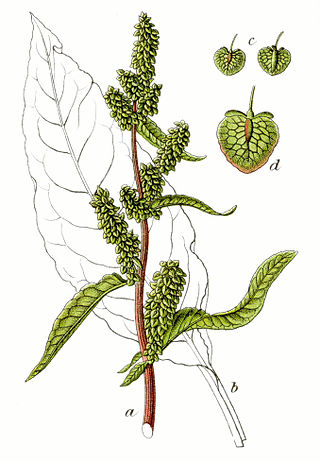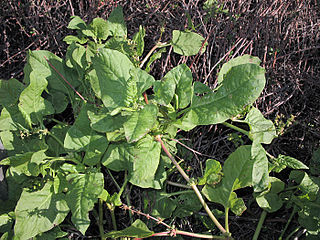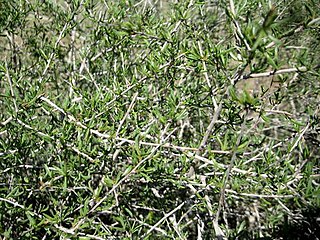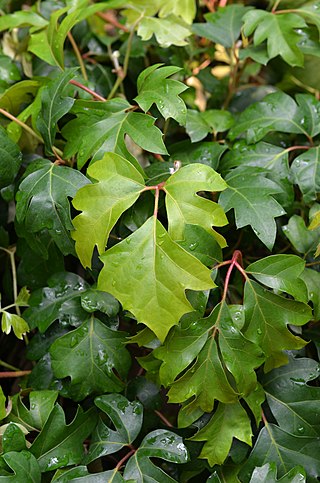
Royal Botanic Gardens, Kew is a non-departmental public body in the United Kingdom sponsored by the Department for Environment, Food and Rural Affairs. An internationally important botanical research and education institution, it employs 1,100 staff. Its board of trustees is chaired by Dame Amelia Fawcett.

Bistorta officinalis, known as bistort, common bistort, European bistort or meadow bistort, is a species of flowering plant in the dock family Polygonaceae native to Europe and northern and western Asia. Other common names include snakeroot, snake-root, snakeweed and Easter-ledges.

In the botanical classification of plants, Aeridinae Pfitzer is a subtribe of the tribe Vandeae whose representatives all have a monopodial growth habit and do not possess pseudobulbs.

The docks and sorrels, genus Rumex, are a genus of about 200 species of annual, biennial, and perennial herbs in the buckwheat family, Polygonaceae. Members of this genus are very common perennial herbs with a native almost worldwide distribution, and introduced species growing in the few places where the genus is not native.

Fallopia is a genus of about 12 species of flowering plants in the buckwheat family, often included in a wider treatment of the related genus Polygonum in the past, and previously including Reynoutria. The genus is native to temperate and subtropical regions of the Northern Hemisphere, but species have been introduced elsewhere. The genus includes species forming vines and shrubs.

Selenicereus, sometimes known as moonlight cactus, is a genus of epiphytic, lithophytic, and terrestrial cacti, found in Mexico, Central America, the Caribbean and northern South America. The term night-blooming cereus is also sometimes used, but this is also used for many night-blooming cacti, including Epiphyllum and Peniocereus. In 2017, the genus Hylocereus was brought into synonymy with Selenicereus. A number of species of Selenicereus produce fruit that is eaten. The fruit, known as pitaya or pitahaya in Spanish or as dragon fruit, may be collected from the wild or the plants may be cultivated.

Libidibia coriaria, synonym Caesalpinia coriaria, is a leguminous tree or large shrub native to the Caribbean, Central America, Mexico, and northern and western South America. Common names include divi-divi, cascalote, guaracabuya, guatapana, nacascol, tan yong, and watapana (Aruba).

Muehlenbeckia or maidenhair is a genus of flowering plants in the family Polygonaceae. It is native to the borders of the Pacific, including South and North America, Papua New Guinea and Australasia. It has been introduced elsewhere, including Europe. Species vary in their growth habits, many being vines or shrubs. In some environments, rampant species can become weedy and difficult to eradicate.

Rumex spinosus, commonly known as devil's thorn, spiny dock, or lesser jack, is an annual herbaceous plant of the Polygonaceae. It originates in the warmer parts of the old world, but now has spread with humans to other places. It is common in disturbed areas, especially in sandy soils. It has shown some weedy behaviour in restricted areas within southern Australia.

Pteropyrum is a genus of plants in the family Polygonaceae. Plants of the World Online accepts two species, native to Iran, Oman and the Gulf States.

Wulfenia is a plant genus in the family Plantaginaceae. The genus was named after Franz Xaver von Wulfen (1728–1805), an Austrian botanist, zoologist, mineralogist, alpinist, and Jesuit priest. It was first described in 1781 by Nikolaus Joseph von Jacquin in. It is also in Tribe Veroniceae.

Nymphaea nouchali, often known by its synonym Nymphaea stellata, or by common names blue lotus, star lotus, red water lily, dwarf aquarium lily, blue water lily, blue star water lily or manel flower, is a water lily of genus Nymphaea. It is native to southern and eastern parts of Asia, and is the national flower of Bangladesh and Sri Lanka. In Sanskrit it is called utpala. This species is usually considered to include the blue Egyptian lotus N. nouchali var. caerulea. In the past, taxonomic confusion has occurred, with the name Nymphaea nouchali incorrectly applied to Nymphaea pubescens.
Epidendrum spruceanum is an epiphytic reed-stemmed Epidendrum orchid native to the Tropical rainforest of Peru, Bolivia, and Brazil.

Solenangis is a genus of flowering plants from the orchid family, Orchidaceae. It is native to sub-Saharan Africa.

Lumnitzera is an Indo-West Pacific mangrove genus in the family Combretaceae. An English common name is black mangrove. Lumnitzera, named after the German botanist, Stephan Lumnitzer (1750-1806), occurs in mangroves from East Africa to the Western Pacific, and northern Australia.
The Plant List was a list of botanical names of species of plants created by the Royal Botanic Gardens, Kew and the Missouri Botanical Garden and launched in 2010. It was intended to be a comprehensive record of all known names of plant species over time, and was produced in response to Target 1 of the 2002–2010 Global Strategy for Plant Conservation, to produce "An online flora of all known plants". It has not been updated since 2013, and has been superseded by World Flora Online.

Rumex arifolius, common name maiden sorrel or mountain dock, is a leafy perennial herb in the family Polygonaceae.
Rumex persicarioides is a flowering dicot species in the family Polygonaceae. This species flowers annually in the summer-time but on rare occasions it has been found to be biennial. R. persicarioides is not cultivated for human use and should not be confused with the similarly named genus Persicariae.

Cissus alata, grape ivy, is a species of flowering plant in the family Vitaceae. It is native to the New World Tropics, from Mexico down to Bolivia, and over to Venezuela, Trinidad and Guyana. Under its synonym Cissus rhombifolia, the Venezuela treebine, it has gained the Royal Horticultural Society's Award of Garden Merit.
















